You will no doubt have seen many fish tanks that have an attractive stream of bubbles rising to the surface or perhaps a fish tank ornament that periodically releases a few bubbles in a unique way.
The bubbles are produced by using an external air pump with silicon piping attached that is fed into the tank and connected to an air stone or attached to an ornament.
There is no denying the attractiveness of a stream of bubbles in a fish tank or a quirky ornament releasing bubbles but are there any other benefits?
Why use a fish tank air pump? Let’s find out…
Table of Contents
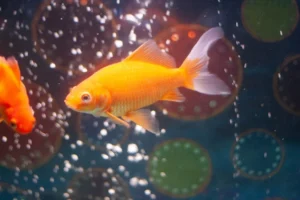
What is an Air Pump for a Fish Tank
An air pump for a fish tank is much like any other air pump in that it moves air by using an electromagnet to rapidly vibrate a rubber diaphragm forcing air out of the outlet hole.
Silicon tubing is attached to the outlet hole and then attached to an air stone which is submerged in the tank releasing a fine stream of bubbles.
An air stone is usually made from porous stone that diffuses the air from the pump into thousands of tiny bubbles.
If large bubbles were released into the tank, without an air stone, they would not only be noisy but also far less effective. The more bubbles, the greater the benefits.
Alternatively, the tubing from the air pump is attached to a fish tank ornament and the bubbles are released through that. Some ‘action’ style ornaments will be moved by the air so that their lids lift up or wheels are turned, etc.
Also, some types of sponge filters are operated by air pumps with the piping being connected directly to them.
Benefits of Fish Tank Air Pumps
What are the benefits of fish tank air pumps?
Gas Exchange / Surface Agitation
Gas exchange occurs at the water’s surface allowing oxygen in and excess CO2 out. Without sufficient surface agitation, this gas exchange cannot take place.
One way to achieve this is by pointing your filter outlet towards the surface so that it disturbs and agitates it.
Another is to use an air pump with an air stone. As the bubbles burst at the surface they push out any excess CO2 and allow oxygen in.
Dissolved oxygen levels in the water should be around 5 and 7 ppm to keep healthy fish, with a level below 2 ppm being very dangerous for your fish’s health.
If you see your fish swimming close to the surface struggling for breath you know they are in trouble and you should take immediate action to increase the surface agitation.
Increased Oxygen
Directly related to surface agitation the greater gas exchange this encourages means more oxygen can enter the water.
This is not only beneficial for your fish but also any plants or invertebrates as well as the good bacteria that is essential for a healthy fish tank.
Improved Circulation
The flow of bubbles to the surface creates a current around it which will improve the general circulation of the water in your tank, particularly if placed in any dead spots away from your filter outlet.
Improved Filtration
With more oxygen in your tank, your biological filtration becomes more effective and the increased water movement means any toxic wastes don’t settle at the bottom of the tank.
The bubbles will also carry tiny waste particles to the surface where they will eventually be drawn back into your filter.
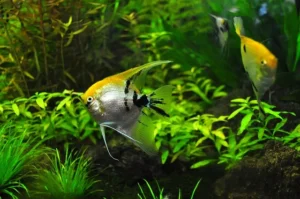
Air Pumps in Planted Tanks
You can use an air pump in a lightly planted tank but it is somewhat counter-productive. Plants use up CO2 during photosynthesis producing oxygen and sugars for food, allowing them to grow and propagate.
A well-planted tank will produce more than enough oxygen during the day to keep your fish healthy.
If you are injecting CO2 in a specialized planted aquarium you should definitely NOT use an air bubbler to remove it!
Air Pumps in Saltwater Tanks
Air pumps are rarely used in saltwater aquariums and if they are it’s mainly for simple quarantine tanks for water circulation.
Air bubbles breaking at the surface in saltwater carry tiny salt particles with them and this would lead to massive salt creep problems possibly damaging any equipment nearby.
Larger saltwater tanks usually use a protein skimmer which is, in essence, a very efficient air bubbler.
What to Look for When Buying a Fish Tank Air Pump
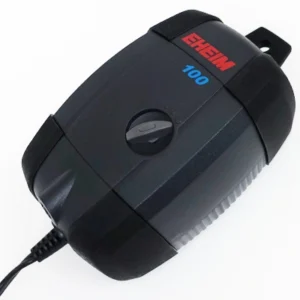
Airflow capacity
If you are just looking for an attractive flow of bubbles using a simple small air stone or wish to use an ‘action’ style tank ornament then any small air pump will do.
However, if you have a larger tank or wish to have an air curtain with a large air stone then you will need a pump with a larger airflow capacity.
There are also pumps with more than one output or you can split the output using a splitter.
Better quality air pumps also allow you to control the flow of air using a dial to maximise or minimise the flow of air.
Noise Level
Perhaps the most important consideration is the noise level of an air pump.
They vibrate. That’s how they work and there’s nothing more annoying than the hum from a noisy air pump, particularly if your tank is in a room where silence is needed, like a bedroom for example.
Put simply, a cheap air pump will be a noisy air pump so don’t pick one based on price alone.
Use a Check Valve
You should always use a check valve when using an air pump in a fish tank. The check valve ensures there is only a one-way flow through the piping from your air pump to your air stone.
Without this, whenever the pump is stopped and air is not flowing through it, the air hose will become a siphon potentially draining water from your tank, back into the pump, and all over your floor!
This will not only fatally damage the pump but could short the electrics in your house. So, always use a check valve with any air pump.
Recommended Fish Tank Air Pumps
We recommend the air pumps below:-
From Eheim:-
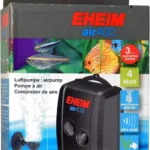 | Eheim Air Pumps | Check pricing on eBay >> *Free UK Delivery |
From Tetra:-
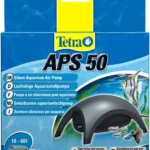 | Tetra Air Pumps | Check pricing on eBay >> *Free UK Delivery |
Recommended Fish Tank Air Stones
Air stones come in many styles and sizes and it’s really a matter of personal choice. Remember, though, that they do degrade and become clogged over time so they will need replacing periodically. It’s a good idea to always have a spare air stone handy.
There are many to choose from here:-
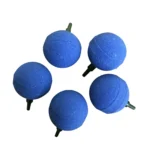 | Air stones | Check pricing on eBay >> *Free UK Delivery |
Fish Tank Air Powered Ornamants
Lots of quirky ones to choose from here:-
 | Air Powered Fish Tank Ornaments | Check pricing on eBay >> |
Fish Tank Air Pump FAQs
Should I leave my aquarium air pump on all the time? – If you are running an air pump there is no reason not to leave it on 24/7. It may even stress your fish if you turn it on and off all the time.
Do air pumps stress fish? – In general, no, although some sensitive fish like bettas may become stressed if the flow of bubbles is too strong.
Fish are more likely to get stressed from the vibration of a noisy air pump. So always place the pump in the cabinet below the tank or on the floor. You can lessen the vibration of a pump by placing it on a foam or sponge mat.
How do I know if my tank has enough oxygen? – The most obvious sign of a lack of oxygen in your tank will be the sight of fish gasping at the surface.
Test kits are available to test the level of dissolved oxygen in the water.
How long do aquarium air stones last? – To some extent, it will depend upon the type and size of air stone used but they should last around 2 -3 months.
You should notice when they begin to get clogged as the air bubbles will decrease or only appear from a certain part of the stone.
